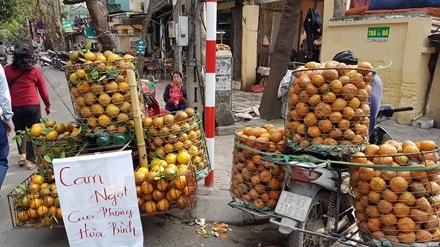Are Vietnamese pomelos Chinese pomelos in disguise?
Although it is the end of the second lunar month, there are still many rough-skinned oranges (sanh oranges) and smooth-skinned oranges for sale on the market. While the sellers claim that these are genuine Ha Giang and Tuyen Quang saanh oranges, some online sellers also claim that these are Chinese oranges imported into Vietnam. So what is the truth?
Mr. Nguyen Duc Vinh - Director of the Department of Agriculture and Rural Development of Ha Giang province, said: Because this is a leap year, the orange season is late. Moreover, at the beginning of the year, the price of oranges was low, so growers held back the fruit to wait for the price to increase. Because of good care, Ha Giang oranges have a fairly high yield, from 15-20 tons/ha. Currently, there are about a few hundred tons left in the province. At this time, the price of fresh oranges cut in the garden fluctuates from 15,000 - 20,000 VND/kg.
However, there is information that the price of 15,000-20,000 VND/kg is only for big, shiny, juicy oranges, while small, ugly oranges are sold at a lower price. Therefore, many families have kept their oranges waiting for the price to go up.
 |
| Ha Giang and Tuyen Quang oranges are similar in appearance because Tuyen Quang oranges are grown in two areas bordering Ha Giang province. |
The price of oranges has dropped, and a part of the orange growing area in Ha Giang is being spontaneously expanded by growers. Mr. Nguyen Duc Vinh also expressed that the provincial agricultural sector has planned an area of about 5,000 hectares for orange growing in the area, but it is very difficult because people have expanded the area themselves, so the statistics are incomplete, the area of orange growing in the area is currently about 6,000 hectares. "If people arbitrarily expand the area further, it will be very dangerous, causing an oversupply that will cause the price of Ha Giang's specialty orange to fall" - Mr. Vinh expressed his opinion.
Ms. Ta Thi Thu - Director of Ham Yen Fruit Tree Center (Department of Agriculture and Rural Development of Ha Giang province) said: Ham Yen district has over 7,000 hectares of oranges, of which 5,900 hectares are pomelos, with an output of over 100,000 tons/year. There are still about 3,000 tons in the garden. Ms. Thu said that the juicy pomelos in the high mountains are shipped to the South for consumption, the rest are sold in the northern provinces. Tuyen Quang pomelos are grown mainly in Ham Yen and Chiem Hoa districts. These are two districts bordering Ha Giang, so Tuyen Quang pomelos have a delicious taste that is not inferior to Ha Giang pomelos. Tuyen Quang pomelos end their season around the beginning of the second lunar month. However, if kept in the garden, the season can be extended.
According to the Department of Cultivation of the Department of Agriculture and Rural Development of Ha Giang province, the characteristic of Ha Giang oranges is that the skin is slightly yellow, and in some places it is slightly moldy. When the orange is cut open, there are seeds inside, the flesh is dark yellow, juicy, and has a sweet taste and aroma when eaten. "Ham Yen oranges ripen naturally on the tree, not wrapped in plastic bags, cut fresh from the fruit and packed in boxes for consumption, absolutely no spraying, incubation, or chemical stimulation to accelerate ripening, so consumers can rest assured when using them" - Ms. Ta Thi Thu committed.
According to Ms. Thu, consumers should not be afraid, because through research we found that China does not have the rough-skinned navel orange variety, but mainly the seedless, smooth-skinned navel orange variety (similar in appearance to V2 oranges, also known as lemon oranges), so it is unlikely that China will fake the label of Tuyen Quang navel oranges. However, currently, orange growers in Ha Giang and Tuyen Quang provinces do not wrap the oranges in plastic, nor do they use chemicals, so if this situation appears on the market, it is possible that the orange variety is not from Ha Giang and Tuyen Quang, or the traders wrap it themselves for preservation.
According to Lao Dong Newspaper

